
4/20/23
AIM
models are limited to a single voice radio transmitter and receiver system for control inside airspace managed
by and/or delegated to the DoD.
3.
Many of the larger public UAS are equipped with transponders to assist ATC with position and tracking
information. These UAS usually operate under IFR under positive ATC control and will tend to be found at very
high altitudes; not likely to be encountered by civil aircraft operators. Launch and recovery operations will be
likewise under positive ATC control and these UAS will be separated from any other known aircraft traffic.
Encounters with low
−
altitude small UAS, being flown in uncontrolled airspace or under low
−
altitude controlled
airspace authorizations, are therefore unlikely. In accordance with 14 CFR Section 91.215(e)(2), ATC
Transponder and Altitude Reporting Equipment and Use, no person may operate an unmanned aircraft under
Part 91 with a transponder on unless: (1) the operation is conducted under a flight plan and the person operating
the unmanned aircraft maintains two
−
way communications with ATC; or (2) the use of a transponder is otherwise
authorized by the Administrator.
NOTE
−
In accordance with 14 CFR Section 107.52, ATC Transponder Equipment Prohibition, unless otherwise authorized by the
Administrator, no person may operate a sUAS under Part 107 with a transponder on.
REFERENCE
−
14 CFR Section 91.215, ATC Transponder and Altitude Reporting Equipment and Use.
14 CFR Section 107.52, ATC Transponder Equipment Prohibition
.
e.
Large Public UAS Launch, Recovery, and Operating Areas:
1.
Large public UAS operations are widespread, they are also carefully managed to ensure enhanced safety
for other NAS users. For this reason, DoD UAS operate in many types of special use airspace. See FIG 11
for examples of Special Use Airspace (SUA) used by DoD UAS.
Large UAS (MGOW 55 Pounds or More)
11
−
3
−
3